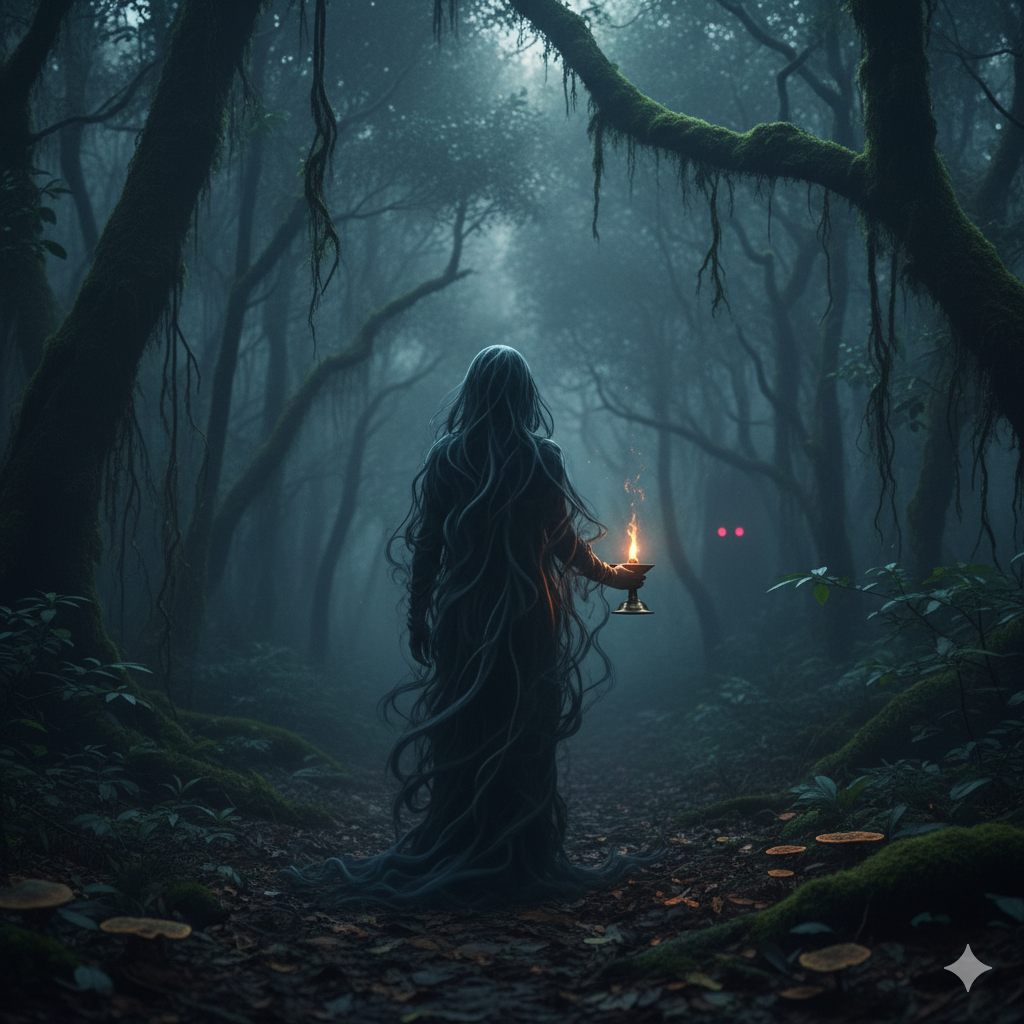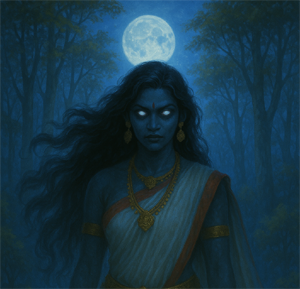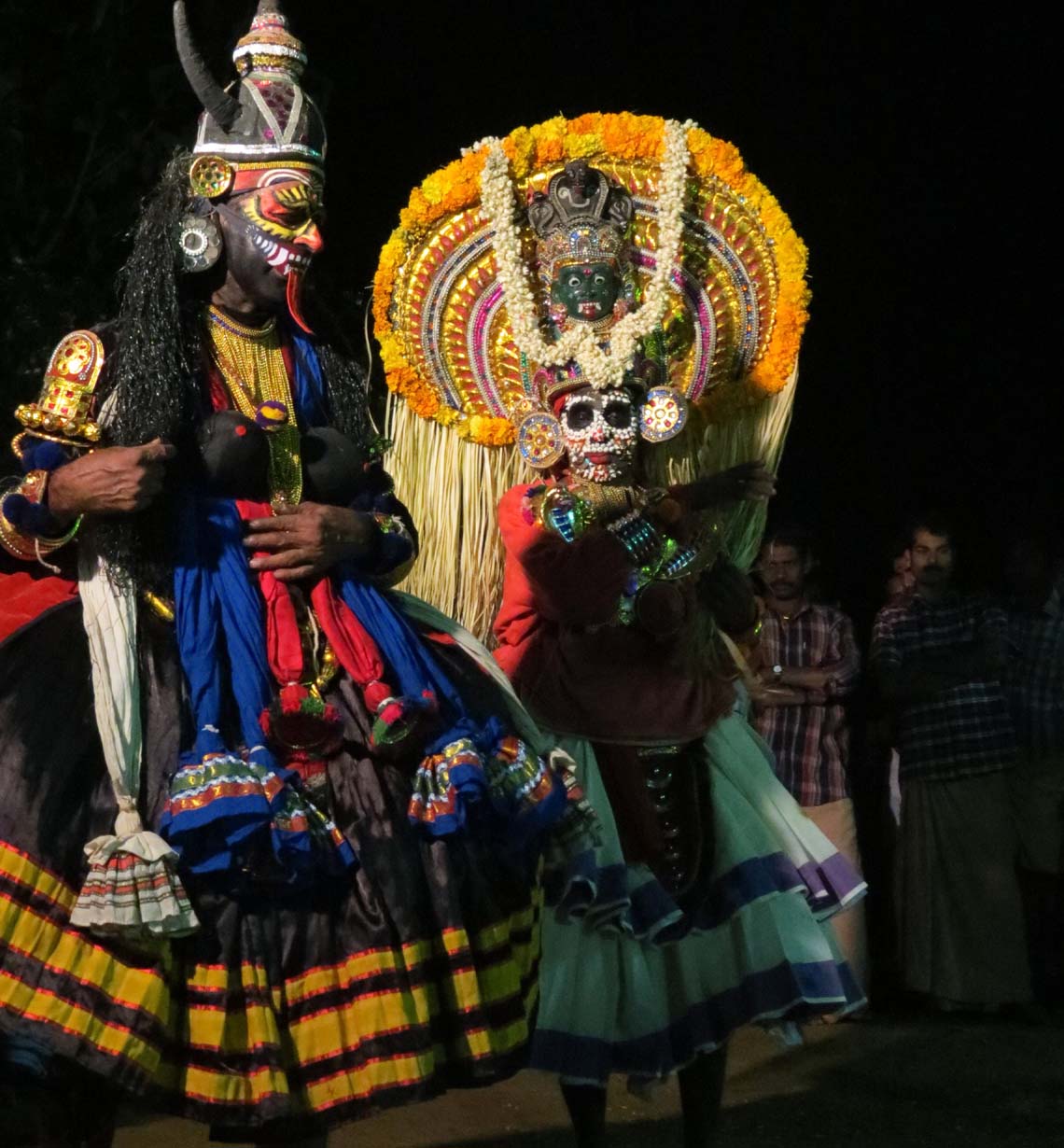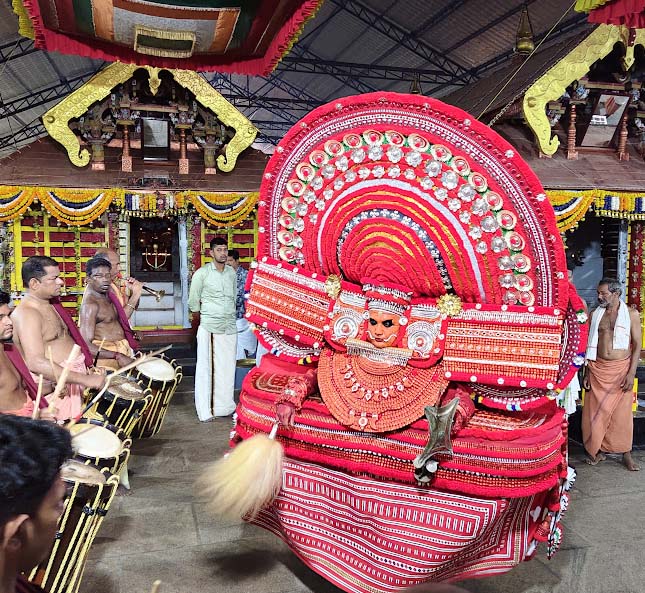Unmasking the Collective Unconscious: The Jungian Archetypes of Shadow, Hero, and the Sacred Feminine in Kerala Folklore
AI generated image

I. Prologue: Kerala’s Inner Landscape and the Call to Myth
1.1. Decoding the Universal Psyche: Establishing the Jungian Foundation
The human experience, spanning millennia and cultures, is unified by profound, universal psychological patterns. Carl Gustav Jung, the Swiss psychiatrist and founder of analytical psychology, mapped these patterns as archetypes— innate, inherited ideas and images that reside within the collective unconscious.1 These archetypes serve as psychological blueprints, guiding human behavior and influencing personality.2 When archetypes are activated, they manifest symbolically in the stories we tell, the myths we cherish, and the dreams that shape our understanding of the world.2
Three foundational archetypes are pivotal to this psychological landscape: The Hero (representing the ego’s journey and triumph), The Shadow (encapsulating our repressed, disowned darkness), and the Anima/Animus (representing the inner feminine and masculine energies, often seen as the Sacred Feminine).4 Recognizing these elemental forces is not merely an academic exercise; Jung posited that understanding and integrating these archetypes are central to the process of Individuation.4 Individuation is the lifelong psychological journey toward wholeness, self-realization, and the development of a unique identity.3 The path toward wholeness necessitates a confrontation with the unconscious elements of the psyche.
1.2. Why Kerala? The Intersection of Dravidian Mysticism and Psychological Reality
To study the profound intersection of myth and psychology, one must turn to cultures where ancient narratives are still vibrantly alive. Kerala, often heralded as "God's Own Country," presents a uniquely rich mythological landscape.6 This region preserves ancient oral traditions, such as the Aithihyamala and the Vadakkan Pattukal, and sustains living ritual arts, including Theyyam and Mudiyettu, making it a powerful crucible for analyzing the collective unconscious.7
The philosophical bedrock of Indian culture deeply influenced Jung himself, who explicitly acknowledged the impact of Eastern thought on his theory of archetypes.9 A powerful parallel exists between Jung's drive toward wholeness and the Hindu spiritual goal of Moksha (liberation).10 The reconciliation of opposites, a core tenet of Jungian psychology, finds a striking mythical antecedent in the Hindu concept of Ardhanarishvara, the composite form of Shiva and Parvati, symbolizing harmonious integration of masculine and feminine principles necessary for spiritual evolution.10
The cultural fabric of Kerala is particularly relevant for an archetypal study due to its history of matriarchal leanings and the profound centrality of goddess worship, known as Shaktism.11 This deep cultural reverence for the Divine Feminine sets the stage for the dramatic, often untrammeled, expression of the Great Mother archetype, providing an unparalleled opportunity to explore the full spectrum of feminine power, from nurturing benevolence to fierce martial might. The cultural acknowledgement of this internal dynamic—the integration of inner opposites—is implicitly present in the cultural and ritualistic landscape, setting the stage for the analysis of the Hero, the Shadow, and the Sacred Feminine.
II. The Shadow: Embracing the Darkness of the Malabar Psyche
2.1. The Nature of the Shadow: Repression and Projection
The Shadow archetype is arguably the most challenging to confront, as it contains all the traits, emotions, and desires the ego rejects or deems incompatible with its conscious self-image.4 It embodies inner darkness, driven by primal instinct, often described as emotional and violent.12 Carl Jung warned that the less the Shadow is consciously integrated into the individual's life, the "blacker and denser" its effect becomes, capable of manifesting a "positively demonic dynamism".12 When repressed, these dark qualities are frequently projected onto external figures or entire groups within society. Kerala folklore provides two distinct externalizations of this collective and personal darkness: the Odiyan and the Yakshi.
2.2. The Odiyan: The Shape-Shifting Shadow of Caste and Conflict
The Odiyan, a fearsome figure rooted in the oral traditions of North Kerala (Malabar), epitomizes the raw, primal energy of the Shadow. Described as a night-dwelling shape-shifter, the Odiyan is a master of Odividya, a form of occult knowledge used to transform into terrifying half-man, half-beast forms like bulls, buffaloes, or jackals to frighten or kill opponents.14 The figure thrived in an atmosphere of secrecy and fear during feudal times in areas like Palakkad and Malappuram.14
A Jungian analysis of Odiyan folklore and caste history reveals that this figure functions as the Collective Societal Shadow of Kerala. The myth is not simply about supernatural terror; it is intrinsically linked to caste marginalization and social conflict.15 Historical records and regional histories identify practitioners of Odividya (Odiyans) primarily within the marginalized Pulayar community.14 This supernatural power became a means for the oppressed to "hit back at their oppressors".17 The terror the Odiyan inspired in the dominant society was, in a profound psychological sense, the projection of that society’s guilt and fear over its own systemic injustice. The monstrousness of the Odiyan is the cultural manifestation of historical social repression, a veiled confession that the community was conscious of the dangerous imbalance it maintained. For individuation to occur at the collective level, the historical trauma embodied by the Odiyan must be acknowledged, rather than merely feared as superstition.
2.3. The Yakshi (Kalliyankattu Neeli): The Terrifying Anima Projection
AI generated image

The figure of the Yakshi, specifically Kalliyankattu Neeli, provides a stark contrast, representing the unbound, primal feminine Shadow. Neeli is a seductive yet bloodthirsty female spirit said to reside in sacred trees, embodying dangerous, chaotic desire.18 In traditional retellings, she represents the potent, untamed aspect of the feminine principle (Eros) that threatens rational order.
The legends surrounding Neeli often culminate in her confrontation with Kadamattathu Kathanar, the legendary occultist priest.20 The Kathanar, functioning as the Logos (masculine, rational principle), subdues the Yakshi and persuades her to redirect her destructive energy toward safeguarding people.22 This narrative arc reflects the societal necessity of containing chaotic psychic forces, reinforcing male and ritual control over powerful female autonomy.20
IV. The Sacred Feminine: Shakti, Sovereignty, and the Great Mother
4.1. The Dynamic Anima in Matriarchal Contexts
The Anima represents the archetypal feminine principle in the psyche, associated with Eros (the principle of relationship and union), life, and the unconscious itself.30 In the cultural context of Kerala, this feminine force is revered as Shakti (Divine Energy) and the all-encompassing Great Mother, reflecting the region's strong matriarchal history.11 The Mother archetype is inherently dual: encompassing nurturing, love, and protection, but also capable of manifesting as the Terrible Mother—the possessive, destructive, and potentially deadly force that battles the emerging ego.24 Kerala’s goddess worship fully embraces this necessary ambivalence.
4.2. Bhadrakali: The Terrible Mother Archetype and Cultural Integration
Bhadrakali, a powerful form of the Great Mother, is central to Kerala’s ritual life and mythology. The pivotal Bhadrakali myth sacred feminine analysis and Terrible Mother archetype focuses on the Bhadrakali-Darika narrative, which is ritually enacted in sacred art forms like Mudiyettu and Theyyam.11 Bhadrakali is born from Shiva’s wrath to slay the demon Darika and restore cosmic order, embodying both fierce, martial attributes and protective potency.11
The community’s approach to this fierce aspect demonstrates a sophisticated cultural mechanism for integrating the Terrible Mother archetype. While the fierce divine force might theoretically crave blood, the Kerala tradition offers a crucial reinterpretation: blood-mimicking liquid, known as guruti, is offered to her accompanying spirits rather than to the goddess herself.11 This ritualistic sublimation serves as a cultural device to humanize the fearsome deity, transforming potential terror into controlled, protective reverence and trust. This symbolic act represents a collective integration, allowing the community to safely draw on the aggressive, corrective power of Shakti while consciously managing the dangerous, primal aspects of the archetype.
4.3. Kannagi: The Mortal Feminine Deified
Complementing the divine force of Bhadrakali is the legendary human heroine, Kannagi, the central figure of the Cilappatikāram epic, worshipped in Kerala as the goddess Kodungallur Bhagavathy.35 Kannagi begins as the epitome of the idealized feminine Anima projection—chaste, faithful, and enduring her husband Kovalan’s betrayal and subsequent poverty.37
Her transformation is catalyzed by tragedy: when Kovalan is unjustly executed, Kannagi is shocked out of passivity. Her subsequent rage manifests as absolute, cosmic power.38 She confronts the king, uses her logical argument to prove her husband's innocence (her Logos), and then tears off her breast, cursing the city of Madurai to burn in fiery retribution.35 This aggressive action, demanding justice and restructuring cosmic order, demonstrates the full activation of the feminine principle (Eros) through the discriminating masculine principle (Animus).39 Kannagi’s story shows that profound suffering can force the ego to integrate previously dormant or repressed opposite energies, culminating in her deification. Her transformation represents the psychological truth that the ultimate power of the feminine principle lies in its capacity for cleansing purification and transformative justice. Kannagi is a profound example of Sacred Feminine manifestations in South Indian rituals where mortal anguish is transmuted into divine sovereignty.
V. Archetypal Actualization: The Ritual Crucible of Theyyam and Mudiyettu
5.1. Performance as Psychological Integration

User:Sivavkm, CC BY-SA 3.0 via Wikimedia Commons
The ritualistic art forms of Kerala are the physical manifestation of the collective unconscious in action. Theyyam and Mudiyettu are not mere plays; they are sacred acts where the archetypal figure is deliberately invited to manifest.40 The elaborate preparation, involving striking makeup, massive headdresses, and deep ritual chanting, moves the performer through a journey of transformation "from man to god".7
This process is the direct cultural expression of archetypal constellation and actualization.1 When the performer, now the incarnate deity (Bhagavathi, Kali, or a local hero), blesses the community, resolves conflicts, and answers prayers, the collective psyche directly engages with the raw power of the archetype in a controlled, therapeutic setting.7 This act provides a living glimpse into the structures of the universal psyche, reinforcing cultural identity and spiritual connection.8
5.2. Inverting the Social Shadow through Ritual

Puthiya Bhagavathy Theyyam
The Kerala Theyyam ritual archetypal significance extends far beyond spiritual devotion; it serves as a critical mechanism for psycho-social healing and shadow management. These rituals, which foster familial bonds and cultural identity, have a crucial, often subversive, socio-political role.11
Theyyam performers are traditionally drawn from lower caste communities.11 In the moment of divine possession, the social hierarchy is radically inverted: the performer, temporarily embodying the deity (often a form of Bhagavathi or Kali), is granted the authority to bless and command, even being permitted to enter a Brahmin’s home.11 This periodic, sanctioned inversion provides a necessary societal release valve.
The ritual acts as an ancient form of communal depth psychology, providing a controlled confrontation with the Societal Shadow—the caste inequality identified in the Odiyan myth. By momentarily elevating the marginalized to divine status, the community symbolically acknowledges the inherent injustice and integrates the repressed power of the excluded. This collective psychological action prevents the Shadow's destructive build-up, ensuring that the turbulent forces of the collective unconscious are managed and contained, thereby sustaining societal stability and common identity. Kerala’s ritual art is, therefore, a sophisticated psycho-social technology designed for the health of the entire community.
VI. Conclusion: The Path to Wholeness through Myth
The folklore of Kerala, from the chilling terror of the Odiyan to the fiery sovereignty of Bhadrakali, provides a living, complex map of the Jungian journey toward Individuation. The collective unconscious of Kerala demands confrontation with inherent opposites: the Hero (Aromal Chekavar) must face the danger of his own unintegrated Shadow (Chandu); the masculine principle (Logos) must contain and honor the primal, chaotic feminine (Eros) represented by the Yakshi (Neeli); and the Terrible Mother (Bhadrakali) must be understood not as indiscriminate rage, but as justified, controlled power necessary for cosmic order.
This ancient wisdom offers enduring relevance for the global seeker. The path to psychological wholeness (Moksha) requires embracing conflict and learning from tragedy, teaching us that true power lies not in being flawless, but in constantly striving to integrate the darkness we carry. The rituals of Kerala demonstrate that the ultimate purpose of myth is to provide a blueprint for living, offering individuals and communities the means to confront their shadows and emerge stronger, wiser, and more whole.
References
- 1. Jung, C.G. (1968). The Archetypes and the Collective Unconscious. Princeton University Press.
- 2. Jung, C.G. (1959). The Collected Works of C.G. Jung, Vol. 9. Princeton University Press.
- 3. Edinger, E.F. (1992). Ego and Archetype: Individuation and the Religious Function of the Psyche. Shambhala.
- 4. Campbell, J. (1949). The Hero with a Thousand Faces. Pantheon Books.
- 5. Zimmer, H. (1946). Myths and Symbols in Indian Art and Civilization. Princeton University Press.
- 6. Kunjunni Raja, K. (1980). Contribution of Kerala to Sanskrit Literature. University of Madras.
- 7. Freeman, R. (1999). “Gods, Groves and the Culture of Nature in Kerala.” Modern Asian Studies, 33(2).
- 8. Panikkar, K.N. (1978). Culture and Consciousness in Modern Kerala. Sahitya Akademi.
- 9. Jung, C.G. (1967). Psychology and Religion. Yale University Press.
- 10. Brown, C. (2012). Jung: A Very Short Introduction. Oxford University Press.
- 11. Menon, A.S. (2007). Cultural Heritage of Kerala. DC Books.
- 12. Ayyappapanicker, K. (1999). Indian Narratology. Sterling Publishers.
- 13. Vettam Mani. (1975). Puranic Encyclopaedia. Motilal Banarsidass.
- 14. Freeman, R. (2003). “Folklore and Power: The Odiyan Myth.” Indian Folklore Research Journal, 1(4).
- 15. Namboodiri, M.V. (2018). Folklore and Society: Studies from Malabar. Kerala Folklore Academy.
- 16. Pillai, M. (2020). “Yakshi Legends and Gendered Fears in Kerala.” Asian Ethnology, 79(1).
- 17. Menon, D.D. (2001). Caste and Colonial Modernity. Permanent Black.
- 18. Jung, C.G. (1953). Collected Works, Vol. 7: Two Essays on Analytical Psychology. Princeton University Press.
